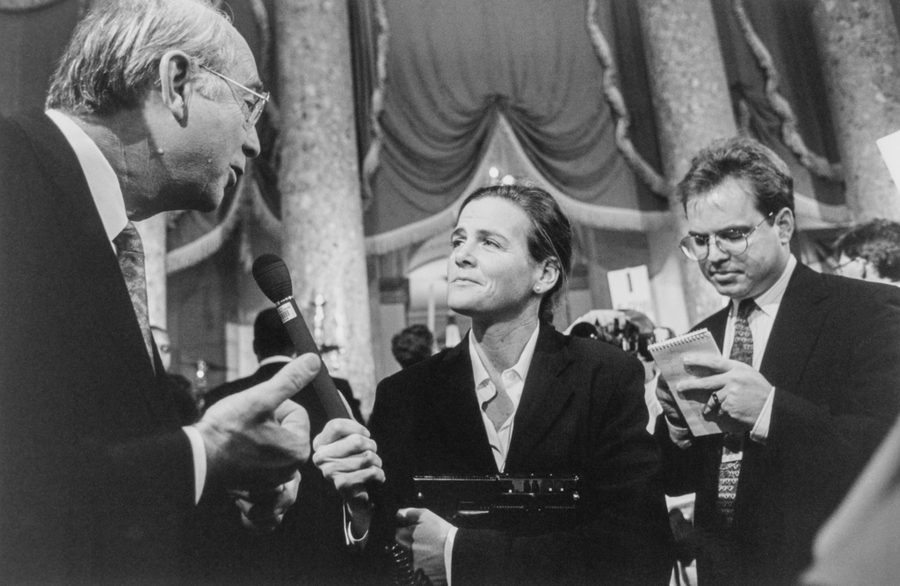On the Air with All (or Most) Things Considered
To mark the 50th anniversary of National Public Radio, we revisit this 1979 story on the station and its flagship program “All Things Considered,” which at the time was known as “Sesame Street for adults.”
Beth Bogart

In the September 12-18, 1979 issue of In These Times, reporter Beth Bogart covered the state of National Public Radio (NPR) and its flagship program “All Things Considered,” both of which launched in the spring of 1971. To mark the 50th anniversary of NPR, we reprint the article in full below, which explored the station’s issues around diversity, funding and political perspectives.
By the time the reporters and producers of National Public Radio’s “All Things Considered” meet for their 10:30 a.m. story conference, they have glanced through a dozen newspapers, watched the morning television news programs and thought about what they want in the 90- minute show to be aired on 220 public radio stations that evening.
The big news one July day is President Carter’s Cabinet reshuffle and the ATC staff, as they call themselves, want to tell the story using an angle different from that presented by newspapers, television or commercial radio. “Let’s get a Russian equivalent of a Kremlin watcher to interpret the Cabinet changes,” is one suggestion. “Yeah, somebody with an authentic-sounding Russian accent,” the idea is seconded.
Aired weekdays from 5:00 p.m. to 6:30, weekends from 5 to 6, ATC has been called an electronic newspaper, a “Sesame Street for adults,” and “better than the New York Times because it has in-depth news, plus ‘comics’.” Award-winning national and international coverage is blended with humor, “inspired zaniness,” in the words of the Wall Street Journal, and minute-long musical breaks every quarter hour that “should be made into an album” one Minneapolis listener suggested.
About 13 stories are usually culled from the morning’s list of 30 possibilities for the show. Approximately half of these come from affiliated stations across the country, from freelancers and from foreign news organizations like the British Broadcasting Corporation (BBC).
“We’re trying to rely less on the BBC and do more of our own reporting from places like Nicaragua, South Africa and Iran,” the program’s producer said. News bureaus are also operating in London, Chicago and other cities around the world, NPR staff said.
ATC has 20 reporters, editors and producers and a $2.7 million budget, all tiny by the standards of commercial networks (its budget is less than 3 percent of CBS News), but large by the standards of “the other alternative network,” Pacifica. NPR’s public relations staff is bigger than Pacifica’s entire news bureau.
NPR often scoops the commercial networks. For example, when the Supreme Court Justices privately decided not to hear the appeals of the Watergate defendants, reporter Nina Tottenberg broke the news. And ATC’s Linda Wertheimer became the first reporter to broadcast from the Senate when she covered live the congressional debate on the Panama Canal treaty.
The government-funded network also avoids other stories it should be covering, Pacifica reporters say. “We’re less timid about controversial stories,” a Washington Pacifica reporter said. “And NPR does not have a political perspective,” she added.
By mid afternoon, the White House watcher has not been found and the idea is shelved, at least for the day’s program. Carter’s Cabinet maneuvers are analyzed instead by former presidential speechwriter James Fallows, who drops into NPR’s Washington, D.C. studio on a few hours’ notice to make a tape; by former CBS reporter Daniel Schorr, a regular commentator on NPR; by Seymour Lipset, who is recorded via telephone from California, and by the editor of the daily Oklahoma newspaper, The Tulsa World.
This last commentator, whose Midwest drawl is distinct despite the telephone-tape static, presents a view from “the heartland” to balance the Washington orientation and “elitism” that NPR is often criticized for.
Minorities
ATC’s 3.5 million audience is 90 percent white, 56 percent college-educated and relatively affluent, according to a Roper survey that NPR brass watch as closely as television executives monitor Neilsen ratings. The show’s staff reflects these demographics, although a concious “affirmative action” campaign at NPR has meant that women hold many of the top resorting jobs. (“We’ve never had a female producer of ATC, though,” one NPR staffer points out.)
NPR “in no way touches the minority population in this country,” one former staffer says. It is this image that network President Frank Mankiewicz says he is committed to changing. “We’re finding that as our audience grows, its characteristics become closer to the general audience,” said the former press secretary of Robert Kennedy, former campaign manager of presidential aspirant Sen. George McGovern, former journalist and lawyer who joined NPR in 1977. “Our listeners are now about 10 per cent non-white and last year this was the fastest growing part of our audience.”
Mankiewicz is credited with giving NPR a new visibility that has increased its audience to almost 5 million. He doubled the size of the news staff, hired professionals such as the former Washington bureau chief of New Times magazine, lobbied successfully for increased government funding and shook up the organization’s upper echelons.
Mankiewicz also expanded the network’s “division of special projects,” which has two goals: to improve the network’s awareness of “minority” concerns in regular programs and hiring practices, and to develop programs to expand NPR’s audience. “Minority” is broadly defined at NPR and the division’s special projects include those for women, Native Americans, Hispanics, Blacks, Asians, the handicapped, senior citizens and children. Among the programs are Enfoque Nacional, a Spanish language news program, and “Crossroads,” which features interviews with prominent minority leaders and artists.
NPR is also broadcasting more “general audience” programs that will appeal to a broader audience. These include Jazz Alive! — a weekly program of taped live performances that boasts the largest audience of any jazz show on network radio —and a radio serial of “Star Wars.” A new morning news program similar to All Things Considered will be aired from 6:00 to 8:00 a.m., beginning November 5. Other NPR offerings include Masterpiece Radio Theater; Shakespeare festival; live coverage of the Los Angeles and San Francisco Philharmonic orchestras; “Earplay,” original radio dramas by the likes of Edward Albee, John Irving and John Gardner; National Press Club luncheons, and the upcoming 12-part series, “A Question of Place,” portraits of artists and thinkers like James Joyce, Bertolt Brecht and Claude Levi-Strauss.
Radio vs. television
NPR’s money comes from the 12-year-old Corporation for Public Broadcasting (CPB), created and funded by Congress. “We have a strange, incestuous relationship with CPB,” one network official said. “On the one hand, they’re right next door and a lot of the people working for NPR used for work for CPB and vice-versa. On the other hand, we have big fights with them over funding,” he said.
CPB must also support the country’s noncommercial television network and has traditionally “favored TV over radio,” according to several NPR staffers. Television costs are substantially higher than radio’s and CPB has doled out the public grants to reflect that. Nonetheless, NPR’s budget climbed from $8.5 million to $12.5 million last year.
Next year, NPR expects to get a much larger share of the CPB pie. The radio network has been getting less than 10 percent of CPB’s budget; next year that percentage is expected to reach 25. “We told CPB that they’re never going to be able to create a top alternative TV network in this country, but that they do have a chance of creating a real alternative radio network,” one NPR executive said.
Before NPR is a “real alternative radio network,” certain problems will have to be dealt with. First, an estimated 34 of the 100 largest metropolitan areas are still not served by a local public radio station; only half the country has access to public radio.
In addition, despite its devoted fans, ATC and the rest of NPR’s programming is only marginally successful in certain spots that do have public radio, like New York and Chicago. Sometimes the weakness is because of the alternative information sources available, but it is also because of the caliber of stations carrying NPR. In New York, Top to bottom: Community radio program for the blind; the New NPR’s Susan Stamberg. volunteers read newspapers on & York Pacifica station, WBAI; for example, the NPR station is city-owned and feels the financial crunch that other city agencies are also feeling. In Chicago, NPR is broadcast on WBEZ, which is owned by the board of education. As an example of its commitment to public radio, the board shut down WBEZ for three days when Mayor Daley died.
NPR also loses stations when they can no longer meet the network’s syndication requirements: broadcast 18 hours a day, a $100,000 annual budget and hire at least seven full-time paid staff.
Mankiewicz speaks of strengthening NPR, perhaps through the network owning and operating its own stations. NPR is currently in the process of being connected to the Westar satellite (used by PBS), which will enable the network to send out four to 20 different shows at once at less cost than it now takes to send out one. In addition, the satellite connection will allow stations to create “mini-networks” to air programs of concern to a particular region.




